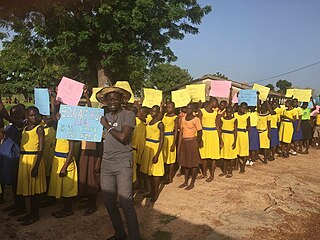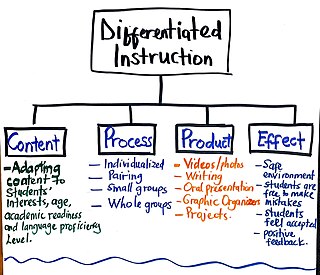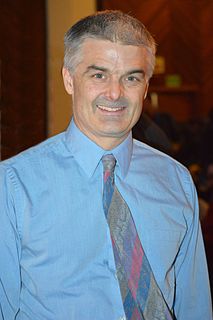
Educational psychology is the branch of psychology concerned with the scientific study of human learning. The study of learning processes, from both cognitive and behavioral perspectives, allows researchers to understand individual differences in intelligence, cognitive development, affect, motivation, self-regulation, and self-concept, as well as their role in learning. The field of educational psychology relies heavily on quantitative methods, including testing and measurement, to enhance educational activities related to instructional design, classroom management, and assessment, which serve to facilitate learning processes in various educational settings across the lifespan.

Learning theory describes how students receive, process, and retain knowledge during learning. Cognitive, emotional, and environmental influences, as well as prior experience, all play a part in how understanding, or a world view, is acquired or changed and knowledge and skills retained.

Bilingual education involves teaching academic content in two languages, in a native and secondary language with varying amounts of each language used in accordance with the program model. Bilingual education refers to the utilization of two languages as means of instruction for students and considered part of or the entire school curriculum, as distinct from simply teaching a second language as a subject.
Mindset is an "established set of attitudes, esp. regarded as typical of a particular group's social or cultural values; the outlook, philosophy, or values of a person; frame of mind, attitude, disposition." A mindset may also arise from a person's world view or philosophy of life.
Instructional scaffolding is the support given to a student by an instructor throughout the learning process. This support is specifically tailored to each student; this instructional approach allows students to experience student-centered learning, which tends to facilitate more efficient learning than teacher-centered learning. This learning process promotes a deeper level of learning than many other common teaching strategies.

Pedagogy, most commonly understood as the approach to teaching, is the theory and practice of learning, and how this process influences, and is influenced by, the social, political and psychological development of learners. Pedagogy, taken as an academic discipline, is the study of how knowledge and skills are imparted in an educational context, and it considers the interactions that take place during learning. Both the theory and practice of pedagogy vary greatly, as they reflect different social, political, and cultural contexts.

Active learning is "a method of learning in which students are actively or experientially involved in the learning process and where there are different levels of active learning, depending on student involvement." Bonwell & Eison (1991) states that "students participate [in active learning] when they are doing something besides passively listening." In a report from the Association for the Study of Higher Education (ASHE), authors discuss a variety of methodologies for promoting active learning. They cite literature that indicates students must do more than just listen in order to learn. They must read, write, discuss, and be engaged in solving problems. This process relates to the three learning domains referred to as knowledge, skills and attitudes (KSA). This taxonomy of learning behaviors can be thought of as "the goals of the learning process." In particular, students must engage in such higher-order thinking tasks as analysis, synthesis, and evaluation.
Learning styles refer to a range of theories that aim to account for differences in individuals' learning. Many theories share the proposition that humans can be classified according to their "style" of learning, but differ in how the proposed styles should be defined, categorized and assessed. A common concept is that individuals differ in how they learn.
Educational technology is the combined use of computer hardware, software, and educational theory and practice to facilitate learning. When referred to with its abbreviation, edtech, it is often referring to the industry of companies that create educational technology.
Ann Lesley Brown (1943–1999) was an educational psychologist who developed methods for teaching children to be better learners. Her interest in the human memory brought Brown to focus on active memory strategies that would help enhance human memory and developmental differences in memory tasks. Her realization that children's learning difficulties often stem from an inability to use metacognitive strategies such as summarizing led to profound advances in educational psychology theory and teaching practices.
An intelligent tutoring system (ITS) is a computer system that aims to provide immediate and customized instruction or feedback to learners, usually without requiring intervention from a human teacher. ITSs have the common goal of enabling learning in a meaningful and effective manner by using a variety of computing technologies. There are many examples of ITSs being used in both formal education and professional settings in which they have demonstrated their capabilities and limitations. There is a close relationship between intelligent tutoring, cognitive learning theories and design; and there is ongoing research to improve the effectiveness of ITS. An ITS typically aims to replicate the demonstrated benefits of one-to-one, personalized tutoring, in contexts where students would otherwise have access to one-to-many instruction from a single teacher, or no teacher at all. ITSs are often designed with the goal of providing access to high quality education to each and every student.

Inclusion in education refers to all students being able to access and gain equal opportunities to education and learning. It arose in the context of special education with an individualized education program or 504 plan, and is built on the notion that it is more effective for students with special needs to have said mixed experience for them to be more successful in social interactions leading to further success in life. The philosophy behind implementation of the inclusion model does not prioritize, but still provides for the utilization of special classrooms and special schools for the education of students with disabilities. Inclusive education models are brought into force by educational administrators with the intention of moving away from seclusion models of special education to the fullest extent practical, the idea being that it is to the social benefit of general education students and special education students alike, with the more able students serving as peer models and those less able serving as motivation for general education students to learn empathy.
Movement in learning or movement-based instruction is a teaching method based on the concept that humans learn better through movement. This teaching method can be applied to students, who should have the opportunity throughout a class period to move around to take "brain breaks" to refocus their attention so they can learn new material. Brain research suggests that physical activity prior to class and during class, increases students' ability to process and retain new material. This is a new and controversial development in education, and, to date, has little research and empirical data to support this trend. However, anecdotal evidence regarding the benefits of incorporating movement in the classroom is promising.

Evidence-based education (EBE) is the principle that education practices should be based on the best available scientific evidence, rather than tradition, personal judgement, or other influences. Evidence-based education is related to evidence-based teaching, evidence-based learning, and school effectiveness research. For example, research has shown that spaced repetition "leads to more robust memory formation than does massed training, which involves short or no intervals".

Differentiated instruction and assessment, also known as differentiated learning or, in education, simply, differentiation, is a framework or philosophy for effective teaching that involves providing all students within their diverse classroom community of learners a range of different avenues for understanding new information in terms of: acquiring content; processing, constructing, or making sense of ideas; and developing teaching materials and assessment measures so that all students within a classroom can learn effectively, regardless of differences in their ability. Differentiated instruction, according to Carol Ann Tomlinson, is the process of "ensuring that what a student learns, how he or she learns it, and how the student demonstrates what he or she has learned is a match for that student's readiness level, interests, and preferred mode of learning." According to Boelens et al. (2018), differentiation can be on two different levels: the administration level and the classroom level. The administration level takes the socioeconomic status and gender of students into consideration. At the classroom level, differentiation revolves around content, processing, product, and effects. On the content level, teachers adapt what they are teaching to meet the needs of students. This can mean making content more challenging or simplified for students based on their levels. The process of learning can be differentiated as well. Teachers may choose to teach individually at a time, assign problems to small groups, partners or the whole group depending on the needs of the students. By differentiating product, teachers decide how students will present what they have learned. This may take the form of videos, graphic organizers, photo presentations, writing, and oral presentations. All these take place in a safe classroom environment where students feel respected and valued—effects.
Multi-age classrooms or composite classes are classrooms with students from more than one grade level. They are created because of a pedagogical choice of a school or school district. They are different from split classes which are formed when there are too many students for one class – but not enough to form two classes of the same grade level. Composite classes are more common in smaller schools; an extreme form is the one-room school.
Concept-Oriented Reading Instruction (CORI) was developed in 1993 by Dr. John T. Guthrie with a team of elementary teachers and graduate students. The project designed and implemented a framework of conceptually oriented reading instruction to improve students' amount and breadth of reading, intrinsic motivations for reading, and strategies of search and comprehension. The framework emphasized five phases of reading instruction in a content domain: observing and personalizing, searching and retrieving, comprehending and integrating, communicating to others, and interacting with peers to construct meaning. CORI instruction was contrasted to experience-based teaching and strategy instruction in terms of its support for motivational and cognitive development.

Jon (Jonathan) Bergmann is a chemistry teacher and one of the developers of the "flipped classroom" model of teaching along with fellow chemistry teacher Aaron Sams. Although already noted for his teaching, Bergmann decided to "flip" what students did in his classes, watching video lectures at home and doing exercises (homework) in class under supervision. He and Sams not only found that grades went up, they also found time for other types of activities, which Bergmann states is more important than the videos. Bergmann has since become the lead technology facilitator for a school in Illinois, and has worked to promote the models speaking at schools, universities and more both in the United States and abroad. He currently teaches science at a high school in suburban Houston Texas.

Teacher leadership is a term used in K-12 schools for classroom educators who simultaneously take on administrative roles outside of their classrooms to assist in functions of the larger school system. Teacher leadership tasks may include but are not limited to: managing teaching, learning, and resource allocation. Teachers who engage in leadership roles are generally experienced and respected in their field which can both empower them and increase collaboration among peers.
Marcus Conyers is an author and developer of graduate degree programs focused on improving leading and learning by bridging mind, brain, and implementation research to practice. Conyers is the coauthor, with Donna Wilson, of 20 books in this field, including Smarter Teacher Leadership: Neuroscience and the Power of Purposeful Collaboration, Teaching Students to Drive Their Brains: Metacognitive Strategies, Activities and Lesson Ideas, Positively Smarter: Science and Strategies for Increasing Happiness, Achievement, and Well-Being, Five Big Ideas for Effective Teaching: Connecting Mind, Brain, and Education Research to Classroom Practice, and Flourishing in the First Five Years: Connecting Implications from Mind, Brain, and Education Research to the Development of Young Children.










